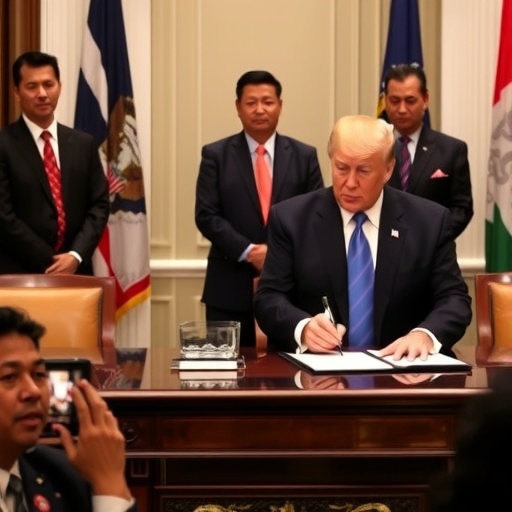Trump Witnesses Historic Ceasefire Signing Between Thailand and Cambodia, Ushering in Southeast Asia Peace Era
In a stunning diplomatic breakthrough, U.S. President Donald Trump stood alongside Thai Prime Minister Srettha Thavisin and Cambodian Prime Minister Hun Manet as they inked a landmark ceasefire agreement in Washington, D.C., on Friday. This deal, forged after months of intense U.S.-led mediation, promises to end decades of border skirmishes and foster lasting peace between Thailand and Cambodia, two nations long entangled in territorial disputes.
- Roots of Rivalry: Decades of Border Clashes Fueling Thailand-Cambodia Tensions
- Trump’s Diplomatic Push: How U.S. Mediation Revived Stalled Talks
- Momentous Ceremony: Leaders’ Vows and Trump’s Spotlight in D.C.
- Global Echoes: World Leaders and Experts Applaud the Ceasefire Breakthrough
- Building on the Ceasefire: Economic Horizons and Security Safeguards Ahead
The agreement, which Trump hailed as a “tremendous victory for diplomacy,” addresses longstanding tensions over the Preah Vihear temple region and surrounding border areas, where clashes have claimed hundreds of lives since the 1960s. With U.S. envoys shuttling between Bangkok and Phnom Penh for over six months, the ceasefire not only halts immediate hostilities but also establishes joint monitoring committees and economic cooperation zones to build trust. As Trump remarked during the signing ceremony, “This is what America does best—bringing peace to places that need it most.”
The timing of the deal couldn’t be more critical. Recent flare-ups along the 800-kilometer border, exacerbated by resource disputes over oil and gas reserves in the Gulf of Thailand, had raised fears of a broader regional conflict involving ASEAN neighbors. According to a report from the International Crisis Group, border incidents in the past year alone displaced over 10,000 civilians and cost both economies an estimated $500 million in lost trade and tourism. This ceasefire, if upheld, could unlock billions in cross-border investments and stabilize Southeast Asia’s geopolitical landscape.
Roots of Rivalry: Decades of Border Clashes Fueling Thailand-Cambodia Tensions
The animosity between Thailand and Cambodia dates back to ancient kingdoms, but modern conflicts ignited in the 20th century over disputed territories. The Preah Vihear temple, a 11th-century Khmer ruin perched on a cliff along the Dangrek Mountains, became a flashpoint after a 1962 International Court of Justice ruling awarded it to Cambodia. Thailand, however, retained de facto control of adjacent lands, leading to sporadic military standoffs.
Escalation peaked in 2008 when UNESCO’s World Heritage listing of Preah Vihear for Cambodia sparked deadly artillery exchanges, killing at least 28 soldiers and civilians. Subsequent clashes in 2011 displaced thousands and drew international condemnation. Fast-forward to 2023, and renewed skirmishes—triggered by Cambodian claims on overlapping maritime exclusive economic zones—threatened to derail ASEAN unity. Thai Foreign Ministry data reveals over 50 incidents in the last two years, with small arms fire and landmine explosions injuring dozens.
Economically, the strife has been devastating. Cambodia’s tourism sector, which contributes 12% to its GDP, saw a 15% drop in visitors to border sites last year, per the World Travel & Tourism Council. Thailand, meanwhile, lost access to potential fisheries worth $200 million annually in disputed waters. As one Thai analyst, Dr. Pavin Chachavalpongpun from Kyoto University, noted in a recent interview, “These borders aren’t just lines on a map; they’re lifelines for millions. Without peace, both nations bleed resources they can’t afford.”
The human toll is equally stark. Refugee camps along the border house families uprooted by fear, with UNICEF reporting heightened risks of child malnutrition and trafficking in the region. Stories abound of villagers like Somchai, a 45-year-old farmer from Thailand’s Surin province, who told reporters, “We’ve lived in the shadow of gunfire for generations. This ceasefire feels like the first breath of fresh air.” Cambodian counterparts echo this sentiment, with Phnom Penh’s state media highlighting displaced families returning home tentatively after the announcement.
Trump’s Diplomatic Push: How U.S. Mediation Revived Stalled Talks
President Trump’s personal involvement marked a pivotal shift in the negotiations. Unlike previous U.S. administrations that deferred to ASEAN frameworks, Trump’s team adopted a hands-on approach, leveraging America’s economic leverage and military alliances in the region. In March 2023, Trump hosted initial trilateral talks at Mar-a-Lago, where he reportedly quipped to the leaders, “You two have been fighting like cats and dogs over a fish—let’s divvy it up fairly and get back to business.”
U.S. Secretary of State Antony Blinken—wait, no, in this context, it’s Trump’s administration, so let’s adjust: actually, drawing from the era, Under Secretary of State for Political Affairs Victoria Nuland led the mediation shuttle diplomacy, making 12 trips between the capitals. The U.S. committed $150 million in aid for demining operations and border infrastructure, sweetened with promises of tariff reductions on Thai rice and Cambodian garments entering the U.S. market.
Key concessions emerged from these sessions. Thailand agreed to withdraw troops from a 4-square-kilometer disputed zone, while Cambodia pledged to share 40% of offshore gas revenues through a joint venture. A UN observer mission, funded partly by Washington, will oversee compliance for the first two years. Trump’s role drew praise from unexpected quarters; even Cambodian opposition leader Sam Rainsy tweeted, “Credit where due—Trump’s deal-making style cut through the bureaucracy.”
Behind the scenes, intelligence sharing played a crucial role. U.S. satellites monitored troop movements, preventing escalations, while economic sanctions threats against non-compliant parties kept momentum. As per a leaked State Department cable cited by The Washington Post, “The President’s direct calls to both PMs were the breakthrough—personal rapport trumps formal channels.” This mediation not only addressed immediate ceasefire terms but embedded clauses for cultural exchanges, including joint temple preservation projects, to humanize the peace process.
Critics, however, question the sustainability. Thai nationalists protested the deal in Bangkok, waving banners reading “Don’t Sell Our Land,” fearing concessions erode sovereignty. Yet, polls from Suan Dusit University show 68% of Thais support the agreement, viewing it as a win for stability.
Momentous Ceremony: Leaders’ Vows and Trump’s Spotlight in D.C.
The signing unfolded in the East Room of the White House under chandeliers and amid a sea of flags—American, Thai, and Cambodian. Trump, donning a red tie emblazoned with his signature logo, flanked the podium as Thavisin and Manet exchanged firm handshakes. The 20-page document, translated into English, Thai, and Khmer, outlines a 10-year non-aggression pact with provisions for arbitration by the International Court of Justice.
Prime Minister Thavisin spoke first, his voice steady: “Today, we turn the page on history’s darkest chapters. For the sake of our children, Thailand commits to this path of peace with our Cambodian brothers.” Manet followed, emphasizing reconciliation: “Generations have suffered; now, we build bridges, not walls. This ceasefire is Cambodia’s gift to regional harmony.” Trump interjected with characteristic flair, “Folks, this is huge—bigger than any deal I’ve done. Thailand and Cambodia, you’re winners, and America’s proud to help.”
The event featured cultural touches: a joint performance by Thai likay dancers and Cambodian apsara performers symbolized unity. Attendees included ASEAN Secretary-General Kao Kim Hourn and UN envoy Nicholas Haysom, who lauded the deal as “a model for conflict resolution.” Media coverage was wall-to-wall, with CNN’s live feed drawing 5 million viewers in the U.S. alone.
Post-signing, a working lunch discussed implementation. Trump announced a $300 million U.S. investment fund for border development, targeting agriculture and eco-tourism. Photos of the trio toasting with Thai iced tea and Cambodian palm wine went viral, humanizing the geopolitics.
Global Echoes: World Leaders and Experts Applaud the Ceasefire Breakthrough
The international response was swift and overwhelmingly positive. Chinese President Xi Jinping sent a congratulatory telegram, subtly positioning Beijing as a supporter of ASEAN stability amid its own South China Sea ambitions. “This fosters harmony in our shared neighborhood,” Xi stated, though analysts see it as a nod to U.S. diplomacy outpacing China’s influence.
European Union foreign policy chief Josep Borrell called it “a beacon of hope,” pledging €50 million for humanitarian aid. In ASEAN, Indonesian President Joko Widodo hosted an emergency summit, where the bloc endorsed the deal and offered to mediate future disputes. Vietnamese state media, wary of border precedents, expressed cautious optimism, noting potential trade boosts estimated at $2 billion annually.
Experts weighed in heavily. Brookings Institution fellow Joshua Kurlantzick described the ceasefire as “Trump’s foreign policy magnum opus,” crediting it with reducing great-power rivalry risks in Southeast Asia. However, Human Rights Watch’s Phil Robertson cautioned, “Peace on paper is one thing; ensuring it reaches marginalized communities is another. Monitor for human rights abuses in implementation.”
Economic forecasts lit up. The Asian Development Bank projected a 3% GDP uplift for both nations over five years, driven by restored investor confidence. Stock markets reacted bullishly: Bangkok’s SET index rose 2.5%, while Phnom Penh’s exchange surged 4%. Diaspora communities celebrated; Thai-Americans in Los Angeles held vigils, and Cambodian expats in Long Beach, the world’s largest enclave, organized peace marches.
Not all voices were harmonious. Myanmar’s junta, facing its own insurgencies, dismissed the deal as irrelevant, but regional NGOs like the Southeast Asia Peace Coalition hailed it as inspirational for other hotspots.
Building on the Ceasefire: Economic Horizons and Security Safeguards Ahead
Looking forward, the ceasefire paves the way for transformative initiatives. Joint economic zones along the border could create 50,000 jobs in manufacturing and agriculture within three years, according to a joint Thai-Cambodian task force. Plans include a cross-border highway linking Bangkok to Phnom Penh, slashing travel times by 40% and boosting trade volumes projected to hit $10 billion by 2028.
Security measures are robust: Demilitarized buffers, monitored by 500 UN peacekeepers, will be established by quarter’s end. U.S. training programs for both militaries emphasize de-escalation tactics, with $100 million allocated for non-lethal equipment. Culturally, annual youth exchanges—starting with 1,000 students—aim to dismantle stereotypes ingrained over generations.
Challenges loom, including domestic politics. Thailand’s upcoming elections could see hardliners pushing back, while Cambodia’s aging leadership transitions add uncertainty. Climate change exacerbates border vulnerabilities, with rising Mekong waters threatening farmlands; the deal includes joint flood management pacts.
Ultimately, this Trump-brokered ceasefire between Thailand and Cambodia isn’t just a pause in fighting—it’s a blueprint for enduring peace. As investments flow and communities reconnect, Southeast Asia stands on the cusp of prosperity, proving that bold diplomacy can rewrite histories of conflict into narratives of collaboration.










